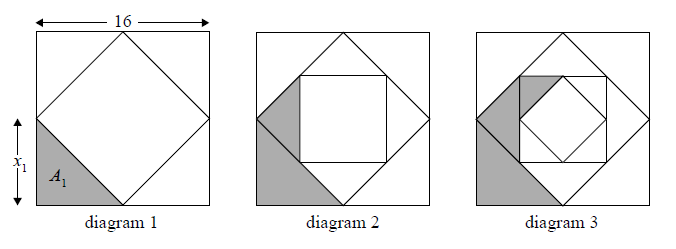| Date | May 2014 | Marks available | 4 | Reference code | 14M.1.sl.TZ1.10 |
| Level | SL only | Paper | 1 | Time zone | TZ1 |
| Command term | Copy and complete | Question number | 10 | Adapted from | N/A |
Question
The sides of a square are 16 cm in length. The midpoints of the sides of this square are joined to form a new square and four triangles (diagram 1). The process is repeated twice, as shown in diagrams 2 and 3.

Let \({x_n}\) denote the length of one of the equal sides of each new triangle.
Let \({A_n}\) denote the area of each new triangle.
The following table gives the values of \({x_n}\) and \({A_n}\), for \(1 \leqslant n \leqslant 3\). Copy and complete the table. (Do not write on this page.)
| \(n\) | 1 | 2 | 3 |
| \({x_n}\) | 8 | 4 | |
| \({A_n}\) | 32 | 16 |
The process described above is repeated. Find \({A_6}\).
Consider an initial square of side length \(k {\text{ cm}}\). The process described above is repeated indefinitely. The total area of the shaded regions is \(k {\text{ c}}{{\text{m}}^2}\). Find the value of \(k\).
Markscheme
valid method for finding side length (M1)
eg \({8^2} + {8^2} = {c^2},{\text{ }}45 - 45 - 90{\text{ side ratios, }}8\sqrt 2 ,{\text{ }}\frac{1}{2}{s^2} = 16,{\text{ }}{x^2} + {x^2} = {8^2}\)
correct working for area (A1)
eg \(\frac{1}{2} \times 4 \times 4\)
| \(n\) | 1 | 2 | 3 |
| \({x_n}\) | 8 | \(\sqrt {32}\) | 4 |
| \({A_n}\) | 32 | 16 | 8 |
A1A1 N2N2
[4 marks]
METHOD 1
recognize geometric progression for \({A_n}\) (R1)
eg \({u_n} = {u_1}{r^{n - 1}}\)
\(r = \frac{1}{2}\) (A1)
correct working (A1)
eg \(32{\left( {\frac{1}{2}} \right)^5};{\text{ 4, 2, 1, }}\frac{1}{2},{\text{ }}\frac{1}{4},{\text{ }} \ldots \)
\({A_6} = 1\) A1 N3
METHOD 2
attempt to find \({x_6}\) (M1)
eg \(8{\left( {\frac{1}{{\sqrt 2 }}} \right)^5},{\text{ }}2\sqrt 2 ,{\text{ 2, }}\sqrt 2 ,{\text{ 1, }} \ldots \)
\({x_6} = \sqrt 2 \) (A1)
correct working (A1)
eg \(\frac{1}{2}{\left( {\sqrt 2 } \right)^2}\)
\({A_6} = 1\) A1 N3
[4 marks]
METHOD 1
recognize infinite geometric series (R1)
eg \({S_n} = \frac{a}{{1 - r}},{\text{ }}\left| r \right| < 1\)
area of first triangle in terms of \(k\) (A1)
eg \(\frac{1}{2}{\left( {\frac{k}{2}} \right)^2}\)
attempt to substitute into sum of infinite geometric series (must have \(k\)) (M1)
eg \(\frac{{\frac{1}{2}{{\left( {\frac{k}{2}} \right)}^2}}}{{1 - \frac{1}{2}}},{\text{ }}\frac{k}{{1 - \frac{1}{2}}}\)
correct equation A1
eg \(\frac{{\frac{1}{2}{{\left( {\frac{k}{2}} \right)}^2}}}{{1 - \frac{1}{2}}} = k,{\text{ }}k = \frac{{\frac{{{k^2}}}{8}}}{{\frac{1}{2}}}\)
correct working (A1)
eg \({k^2} = 4k\)
valid attempt to solve their quadratic (M1)
eg \(k(k - 4),{\text{ }}k = 4{\text{ or }}k = 0\)
\(k = 4\) A1 N2
METHOD 2
recognizing that there are four sets of infinitely shaded regions with equal area R1
area of original square is \({k^2}\) (A1)
so total shaded area is \(\frac{{{k^2}}}{4}\) (A1)
correct equation \(\frac{{{k^2}}}{4} = k\) A1
\({k^2} = 4k\) (A1)
valid attempt to solve their quadratic (M1)
eg \(k(k - 4),{\text{ }}k = 4{\text{ or }}k = 0\)
\(k = 4\) A1 N2
[7 marks]

